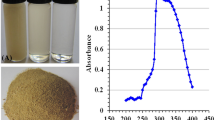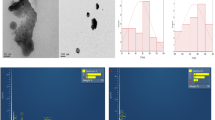Abstract
Biodegradable antifungal nanomaterials are a recent novel measure against plant pathogens. In the present investigation, the synthesis and characterization of some ecofriendly nanomaterials, including silica, chitosan, and copper nanoparticles (NPs) and their combination, were carried out. Their fungicidal activity was studied in vitro and in vivo against Botrytis cinerea, the causal agent of gray mold on table grapes. In addition, the effect of those nanomaterials on physical and chemical properties of grape (TSS, TA, TSS/TA ratio and berries colour) were evaluated. Scanning electron microscopy (SEM) and analysis of DNA-binding profile were used to better understand their mechanism of action. SEM showed that chitosan and silica NPs caused inhibition of hyphal growth and/or alteration of hyphal morphology such as cell wall disruption, withering, and excessive septation. NPs interacted with DNA isolated from fungal mats: the highest concentration of chitosan and silica NPs affected DNA integrity and led to a significant degradation. A single application of chitosan or silica NPs at veraison stage was able to reduce gray mold of table grapes. Although further large scale trials are needed, the promising results of this research suggest nanomaterials compounds, i.e. silica and chitosan NPs, as effective antifungal agents for the control of gray mold of table grapes.






Similar content being viewed by others
References
Abd-Elsalam, K. A., Vasil’kov, Y. A., Said-Galiev, E. E., Rubina, M. S., Khokhlov, A. R., Naumkin, A. V., Shtykova, E. V., & Alghuthaymi, M. A. (2018). Bimetallic blends and chitosan nanocomposites: Novel antifungal agents against cotton seedling damping-off. European Journal of Plant Pathology, 151, 57–72.
Abourida, M., & Harb, F. (2014). Synthesis and characterization of amorphous silica Nanoparitcles from aqueous silicates using cationic surfactants. Journal of Metals, Materials and Minerals, 24, 37–42.
Ahmad, M. B., Lim, J. J., Tay, M. Y., Shameli, K., & Ibrahim, N. A. (2011). Synthesis of silver nanoparticles in chitosan, gelatin and chitosan/gelatin bionanocomposites by a chemical reducing agent and their characterizations. Molecules, 16, 7237–7248.
Ahmed, A. I. S. (2017). Chitosan and silver nanoparticles as control agents of some Faba bean spot diseases. Journal of Plant Pathology and Microbiology, 8, 421.
Baek, S.-H., Kim, B., & Suh, K.-D. (2008). Chitosan particle/multiwall carbon nanotube composites by electrostatic interactions. Colloids and Surfaces, A: Physicochemical and Engineering Aspects, 316, 292–296.
Barnett, H. L., & Hunter, B. B. (1986). Illustrated genera of imperfect Fungi (4th ed.). New York: Macmillan Publishing Co. 218 pp.
Bernardos, A., Marina, T., Žáˇcek, P., Pérez-Esteve, É., Martínez-Máñez, R., Lhotka, M., Kouřimská, L., Pulkrábek, J., & Klouček, P. (2015). Antifungal effect of essential oil components against Aspergillus niger when loaded into silica mesoporous supports. Journal of the Science of Food and Agriculture, 95, 2824–2831.
Bowen, P., Menzies, J., Ehret, D., Samuels, L., & Glass, A. D. M. (1992). Soluble silicon sprays inhibit powdery mildew development on grape leaves. Journal of the American Society for Horticultural Science, 117, 906–912.
Carreño, J., & Martinez, A. (1995). Proposal of an index for the objective evaluation of the colour of red table grapes. Food Research International, 28, 373–377.
Dang, T. M. D., Le, T. T. T., Fribourg-Blanc, E., & Dang, M. C. (2011). Synthesis and optical properties of copper nanoparticles prepared by a chemical reduction method. Advances in Natural Sciences: Nanoscience and Nanotechnology, 2, 015009.
Dann, E. K., & Muir, S. (2002). Peas grown in media with elevated plant-available silicon levels have higher activities of chitinase and β-1,3-glucanase, are less susceptible to a fungal leaf spot pathogen and accumulate more foliar silicon. Australasian Plant Pathology, 31, 9–13.
Dinh, S.-Q., Joyce, D. C., Irving, D. E., & Wearing, A. H. (2007). Field applications of three different classes of known host plant defence elicitors did not suppress Botrytis cinerea infecting Geraldton waxflower. Australasian Plant Pathology, 36, 142–148.
Dinh, S.-Q., Joyce, D. C., Irving, D. E., & Wearing, A. H. (2008). Effects of multiple applications of chemical elicitors on Botrytis cinerea infecting Geraldton waxflower. Australasian Plant Pathology, 37, 87–94.
Divya, K., Vijayan, S., Tijith, K. G., & Jisha, M. S. (2017). Antimicrobial properties of chitosan nanoparticles: Mode of action and factors affecting activity. Fibers and Polymers, 18(2), 221–230.
El Ghaouth, A., Arul, J., & Benhamou, N. (1992). Antifungal activity of chitosan on post-harvest pathogens. Induction of morphological and cytological alterations in Rhizopus stolonifer. Mycological Research, 96(9), 769–779.
He, L., Liu, Y., Mustapha, A., & Lin, M. (2011). Antifungal activity of zinc oxide nanoparticles against Botrytis cinerea and Penicillium expansum. Microbiological Research, 166(3), 207–215.
Hernández-Lauzardo, A., Velázquez, M., & Guerra-Sánchez, M. (2011). Current status of action mode and effect of chitosan against phytopathogens fungi. African Journal of Microbiology Research, 5, 4243–4247.
Jacometti, M. A., Wratten, S. D., & Walter, M. (2010). Review: Alternatives to synthetic fungicides for Botrytis cinerea management in vineyards. Australian Journal of Grape and Wine Research, 16, 154–172.
Joselito, D., & Soytong, K. (2014). Construction and characterization of copolymer nanomaterials loaded with bioactive compounds from Chaetomium species. Journal of Agricultural Technology, 10(4), 823–831.
Kaur, M., Kalia, A., & Thakur, A. (2017). Effect of biodegradable chitosan–rice-starch nanocomposite films on post-harvest quality of stored peach fruit. Starch, 69, 1600208.
Li, L. H., Deng, J. C., Deng, H. R., Liu, Z. L., & Li, X. L. (2010). Preparation, characterization and antimicrobial activities of chitosan/ag/ZnO blend films. Chemical Engineering Journal, 160, 378–382.
Liu, X. F., Guan, Y. L., Yang, D. Z., Li, Z., & Yao, K. D. (2001). Antibacterial action of chitosan and carboxymethylated chitosan. Journal of Applied Polymer Science, 79, 1324–1335.
Liu, H. Y., Du, X., & Wang, L. S. (2004). Chitosan kills bacteria through cell membrane damage. International Journal of Food Microbiology, 95, 147–155.
Menzies, J., Bowen, P., Ehret, D., & Glass, A. D. M. (1992). Foliar application of potassium silicate reduce severity of powdery mildew on cucumber, muskmelon, and zucchini squash. Journal of the American Society for Horticultural Science, 117, 902–905.
Mohammadi, A., Hashemi, M., & Hosseini, S. M. (2015). Nanoencapsulation of Zataria multiflora essential oil preparation and characterization with enhanced antifungal growth for controlling Botrytis cinerea, the causal agent of gray mould disease. Innovative Food Science & Emerging Technologies, 14, 78–84.
Moslem, M. A., Abd-Elsalam, K. A., Bahkali, A. H., & Yassin, M. A. (2010). First morpho-molecular identification of Penicillium griseofulvum and P. aurantiogriseum toxicogenic isolates associated with blue mold on apple. Foodborne Pathogens and Disease, 7, 857–861.
Mott, D., Galkowski, J., Wang, L. Y., Luo, J., & Zhong, C. J. (2007). Synthesis of size-controlled and shaped copper nanoparticles. Langmuir, 23, 5740–5745.
Moussa, S. H., Tayel, A. A., Alsohim, A. S., & Abdallah, R. R. (2013). Botryticidal growth of Nanosized silver–chitosan composite and its application for the control of gray Mold in strawberry. Journal of Food Science, 78, 1589–1594.
Muzzarelli, R. A. (2011). Potential of chitin/chitosan-bearing materials for uranium recovery: An interdisciplinary review. Carbohydrate Polymers, 84, 54–63.
Nair, R. & Kumar, D.S. (2013). Plant Diseases—Control and Remedy Through Nanotechnology. pp. 231–244. Book Crop Improvement Under Adverse Conditions Edited by Narendra Tuteja and Sarvajeet Singh Gill.
Nemati, A., Shadpour, S., Khalafbeygi, H., Ashraf, S., Barkhi, M., & Soudi, R. M. (2015). Efficiency of hydrothermal synthesis of nano/micro sized copper and study on in vitro antifungal activity. Materials and Manufacturing Processes, 30(1), 63–69.
Pichyangkura, R., & Chatchawan, S. (2015). Bio stimulant activity of chitosan in horticulture. Scientia Horticulturae, 195, 49–65.
Rabea, E. I., & Steurbaut, W. (2010). Chemically modified chitosans as antimicrobial agents against some plant pathogenic bacteria and fungi. Plant Protection Science, 4, 149–158.
Reglinski, T., Elmer, P. A. G., Taylor, J. T., Wood, P. N., & Hoyte, S. M. (2010). Inhibition of Botrytis cinerea growth and suppression of botrytis bunch rot in grapes using chitosan. Plant Pathology, 59, 882–890.
Rossi, L. M., Shi, L. F., Quina, F. H., & Rosenzweig, Z. (2005). Stober synthesis of monodispersed luminescent silica nanoparticles for bioanalytical assays. Langmuir, 21, 4277–4280.
Saharan, V., Sharma, G., Yadav, M., Choudhary, M. K., Sharma, S. S., Pal, A., Raliya, R., & Biswas, P. (2015). Synthesis and in vitro antifungal efficacy of cu–chitosan nanoparticles against pathogenic fungi of tomato. International Journal of Biological Macromolecules, 75, 346–353.
Salahuddin, N., Elbarbary, A., Allam, N., & Hashim, A. F. (2018). Chitosan modified with 1,3,4-oxa(thia)diazole derivatives with high efficacy to heal burn infection by Staphylococcus aureus. Journal of Bioactive and Compatible Polymers, 3(3), 254–268.
Sanford, P. A. (2003). Commercial sources of chitin and chitosan and their utilization. In K. M. Varum, A. Domard, & O. SmidsrØd (Eds.), Advances in chitin science (Vol. 6, pp. 35–42). Trondheim: NTNU.
Soytong, K., Charoenporn, C., & Kanokmedhakul, S. (2013). Evaluation of microbial elicitors to induce plant immunity for tomato wilt. African Journal of Microbiology Research, 7(19), 1993–2000.
Stöber, W., Fink, A., & Bohn, E. (1968). Controlled growth of mono disperse silica spheres in the micron size range. Journal of Colloid and Interface Science, 26, 62–69.
Suhartono, D. (2015). Preparation of chitosan material and its antifungal activity for bamboo. International Journal of Science and Research, 6, 1586–1590.
Suriyaprabha, R., Karunakaran, G., Kavitha, K., Yuvakkumar, R., Rajendran, V., & Kannan, N. (2014). Application of silica nanoparticles in maize to enhance fungal resistance. IET Nanobiotechnology, 8(3), 133–137.
Usman, M. S., El Zowalaty, M. E., Shameli, K., Zainuddin, N., Salama, M., & Ibrahim, N. A. (2013). Synthesis, characterization, and antimicrobial properties of copper nanoparticles. International Journal of Nanomedicine, 18, 4467–4479.
Xu, L., Cao, L., Li, F., Wang, X., & Huang, Q. (2014). Utilization of chitosan–lactide copolymer nanoparticles as controlled release pesticide carrier for pyraclostrobin against Colletotrichum gossypii Southw. Journal of Dispersion Science and Technology, 35, 544–550.
Xue, J., Luo, Z., Li, P., Ding, Y., Cui, Y., & Wu, Q. (2014). A residue-free green synergistic antifungal nanotechnology for pesticide thiram by ZnO nanoparticles. Scientific Reports, 4, 5408.
Youssef, K., & Roberto, S. R. (2014a). Applications of salt solutions before and after harvest affect the quality and incidence of postharvest gray mold of ‘Italia’ table grapes. Postharvest Biology and Technology, 87, 95–102.
Youssef, K., & Roberto, S. R. (2014b). Salt strategies to control Botrytis mold of 'Benitaka' table grapes and to maintain fruit quality during storage. Postharvest Biology and Technology, 95, 95–102.
Youssef, K., Ligorio, A., Sanzani, S. M., Nigro, F., & Ippolito, A. (2012). Control of storage diseases of citrus by pre- and postharvest application of salts. Postharvest Biology and Technology, 72, 57–63.
Youssef, K., Hashim, A. F., Margarita, R., Alghuthaymi, M. A., & Abd-Elsalam, K. A. (2017). Antifungal efficacy of chemically-produced copper nanoparticles against Penicillium digitatum and Fusarium solani on Citrus fruit. The Philippine Agricultural Scientist, 100(1), 69–78.
Acknowledgments
This research was supported by the International Foundation for Science, Stockholm, Sweden, through a grant to Ms. Ayat F. Hashim (F5853).
Author information
Authors and Affiliations
Corresponding author
Ethics declarations
Conflict of interest
The authors declare that they have no conflict of interest. The manuscript was prepared under compliance with ethical standards.
Animal studies and human participants
This article does not contain any studies with human participants or animal performed by any of the authors.
Rights and permissions
About this article
Cite this article
Hashim, A.F., Youssef, K. & Abd-Elsalam, K.A. Ecofriendly nanomaterials for controlling gray mold of table grapes and maintaining postharvest quality. Eur J Plant Pathol 154, 377–388 (2019). https://doi.org/10.1007/s10658-018-01662-2
Accepted:
Published:
Issue Date:
DOI: https://doi.org/10.1007/s10658-018-01662-2




